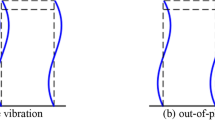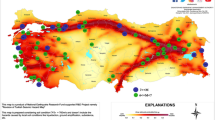Abstract
Research on monitoring and forecasting technology for slope stability is important for ensuring railway operation. This paper presents field investigation of force and displacement within a strata slope using a real-time remote monitoring system. Based on the interactions of the landslide body, the landslide bed and the monitoring anchor of slope, the mechanical principle of relative movement between the landslide body and the landslide bed can be found. This paper puts forward stress data obtained from a monitoring anchor as the main criterion for landslide stability. The stress will change continually inside the slope mass before the occurrence of a landslide. When the sliding force is larger than the anti-sliding force, deformation and landslides will occur; thus, the change in stress occurs before the change in displacement. In this study, the internal stress, deep displacement and surface strain of a railway slope were measured by a real-time remote-monitoring system, and a vibration metre was installed on the surface of the railway slope to study the influence of the train vibration load on the stability of the slope. The monitoring results are synthetically analysed temporally and spatially, then a railway slope forecasting model is proposed. According to the railway slope field application, the forecasting model makes successful predictions.

Cited from the network


















Similar content being viewed by others
References
Carla T, Farina P, Intrieri E, Botsialas K, Casagli N (2017) On the monitoring and early-warning of brittle slope failures in hard rock masses: examples from an open-pit mine. Eng Geol 228:71–81
Chen Y, Yin J, Hu Y (2013) Research on prestress quantitative loss law of soft rock slope anchor cable. Chin J Rock Mech Eng 32(8):1685–1691
Chen XL, Zhou BG, Ran HL et al (2015a) Influence of rock masses properties on the slope stabilities: a study based on slope failures during the 2008 Wenchuan earthquake. In: 12th International IAEG Congress, Torino, Italy, Engineering Geology for Society and Territory, vol 2: landslide processes, pp 1219–1223
Chen T, Deng J, Li L et al (2015b) Deformation characteristics and stability evaluation of a heavily loosened rock slope. Chin J Rock Mech Eng 34(S1):2607–2616
Choquet P, Juneau F, Debreuille PJ, Bessette J (2017) Reliability, long-term stability and gage performance of vibrating wire sensors with reference to case histories. In: Proceedings of the 5th International Symposium on Field Measurements in Geo-mechanics, Singapore
He M (2009) Real-time remote monitoring and forecasting system for geological disasters of landslides and its engineering application. Chin J Rock Mech Eng 28(6):1081–1090
Fu H, Zeng L, Wang G et al (2012) Stability analysis of soft rock slope under rainfall infiltration. Rock Soil Mech 33(8):2359–2365
Hu J, Wang K-K, Dong J-H (2016) Forecasting of slope stability based on BCABC-SVM. J Shenyang Univ Technol 38(2):222–227
Deng H, Li J, Yi Q et al (2009) Research on unloading deformation of soft rock high slope. Rock Soil Mech 30(6):1731–1734
Huang HF, Long JJ, Lin HY, Zhang L, Yi W, Lei BJ (2017) Unmanned aerial vehicle based remote sensing method for monitoring a steep mountainous slope in the Three Gorges Reservoir, China. Earth Sci Inform 10(3):287–301
Lee J, Bae W (2015) A case study on collapse characteristics of slope during construction in the Chung-Cheong area. J Korean Geoenvironmental Soc 16(10):23–32
Li Y (2015) Forecasting of slope displacement based on QPSO-LSSVM method. Mt Res 33(3):374–378
Ma M, Wang J, Li W et al (2014) Identification of potential landslide slippery surface morphology based on displacement monitoring data. Chin J Undergr Space Eng 10(6):1455–1461
Nolesini T, William F, Bianchini S et al (2016) Detecting slope and urban potential unstable areas by means of multi-platform remote sensing techniques: the Volterra (Italy) case study. Remote Sens 8(9):746
Palenzuela JA, Jimenez-Peralvarez JD, El Hamdouni R et al (2016) Integration of LiDAR data for the assessment of activity in diachronic landslides: a case study in the Betic Cordillera (Spain). Landslides 13(4):629–642
Pereira LC, Lana MS (2013) Stress-strain analysis of buckling failure in phyllite slopes. Geotech Geol Eng 31(1):297–314
Qu TT, Lu P, Liu C et al (2016) Hybrid-SAR technique: joint analysis using phase-based and amplitude-based methods for the xishancun giant landslide monitoring. Remote Sens 8(10):874
Silva CHC, Lana MS (2012) Influence of slake durability on geotechnical behavior of phyllites of Pau Branco Mine. Rem Rev Esc Minas 65(3):413–418
Uchimura T, Towhata I, Wang L, Nishie S, Yamaguchi H, Seko I, Qiao J (2015) Precaution and early warning of surface failure of slopes using tilt sensors. Soils Found 55(5):1086–1099
Xiao K, Zhou DP, Li H (2007) Physical modeling of deformation properties for soft rock slope under excavation. Rock Soil Mech 28(1):111–115, 122
Xu M, Guo Z, Li H (2014) Application of multivariable non-equidistance gray forecast model in open-pit slope disaster warning. Sci Survey Map 39(9):83–86
Zhang J, Weiya XU, Haiyuan JIN et al (2009) Safety monitoring and stability analysis of large-scale and complicated high rock slope. Chin J Rock Mech Eng 28(9):1819–1827
Zhu XX, Chen CX, Zheng Y et al (2013) Study of deformation and strength properties of the carbonaceous phyllite under natural and saturated condition. In: 3rd International-Society-for-Rock-Mechanics (ISRM) SINOROCK Symposium, Tongji Univ, Shanghai, Peoples R CHINA, pp 255–259
Acknowledgements
This work was partially supported by Project Mechanism of mega loess slope sliding and catastrophic effect on land reclamation project by gully-hill controlling supported by National Natural Science Foundation of China (Grant no. 41790443), the National Key R&D Program of China (Grant no. 2016YFC0802203), Guangxi Key Laboratory of Geomechanics and Geotechnical Engineering (Grant no. 15-KF-05), Zhejiang Collaborative Innovation Center for Prevention and Control of Mountain Geologic Hazards (Grant no. PCMGH-2017-Z-01) and the Xi’an Railway Fund (Grant no. 2016GG010).
Author information
Authors and Affiliations
Corresponding author
Ethics declarations
Conflict of interest
The authors declare that there are no conflicts of interest regarding the publication of this paper.
Rights and permissions
About this article
Cite this article
Xu, J., Li, H., Du, K. et al. Field investigation of force and displacement within a strata slope using a real-time remote monitoring system. Environ Earth Sci 77, 552 (2018). https://doi.org/10.1007/s12665-018-7729-3
Received:
Accepted:
Published:
DOI: https://doi.org/10.1007/s12665-018-7729-3




